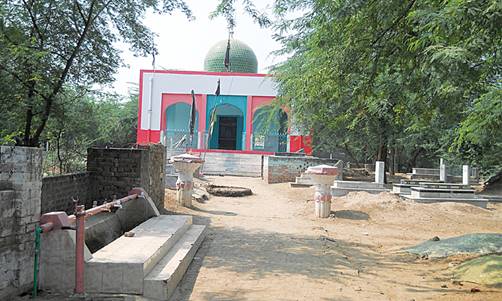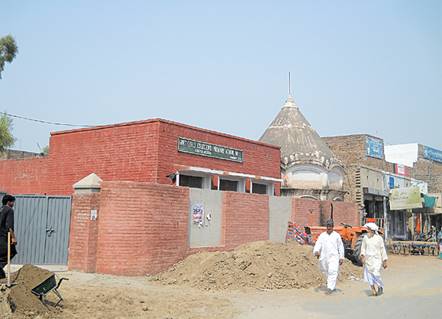Nostalgia: Serenity in Shahpur
By Imtiaz Piracha
DAWN 22 December, 2014
|
The second building on the left was grandpa’s house |
After years of fantasising about the 24-hour-long bus ride from Karachi, where I live, to Rawalpindi, I was finally ready to embark on my coveted cross country adventure, to see my country, rub shoulders with my compatriots and meet old army buddies.
While finalising the 10-day tour, I realised that three hours short of Rawalpindi, the bus would stop near Shahpur, my ancestral village on River Jehlum. Somehow, I could never manage a stopover there in the last 40 years. This time around, I could make time for it as I really wanted to rediscover the scenes of red-beaked green parrots squeaking from tree to tree under a blue sky and cotton clouds, and the eerie graveyard consisting mainly of mud graves and scary tales. I could also retrace one cold rainy night in my grandfather’s company.
Grandpa had held my hand as we stepped out of a bus into the heavy rain in Shahpur. As the bus moved away, its headlights receded and we found ourselves in complete darkness. Grandpa held my hand more firmly. With a trimmed Santa Claus beard, he was reputed to be strong, brave and a pious gentleman. That walk from the bus-stop to home would test his mettle.
In search of his roots, Imtiaz Piracha returns to his village after four decades — only to discover that he was now an alien in the eyes of many
As we stepped into the slippery mud and on the uneven path, using his umbrella as white cane, he decided to walk along the walls of the houses for better navigation and support. Never letting go of my hand. The only sounds were those of lashing rain torrents and occasional muffled barking of stray dogs. Grandpa started reciting prayers, first in whispers then louder whenever we slipped and fell. A 15-minute walk in normal weather took more than an hour before we made it home; fully drenched in mud. I think that brought me even closer to grandpa. He died long time ago and was buried in Shahpur.
 |
A view of the main bazaar |
The temptation to stopover at Shahpur was strong, but I was not sure whether I hesitated because of the inevitable changes it would entail, or some fear of the unknown.
My hesitation had been because I did not know a soul in the village where my parents, grandparents and their grandparents were born and had lived. Our entire tribe had moved out to big cities or foreign countries, abandoning their ancestral homes — a phenomenon of urbanisation.
However, the tragic irony of abandoning our roots, cast a permanent shadow wherever in the world the diaspora resettled. My generation was born in various cities and countries. My children’s generation could not even speak the dialect of our forefathers. I believe if it wasn’t mainly for one dying tradition of rural barter trade, our younger generation would have forgotten the name of Shahpur altogether.
 |
Village graveyard around Shah Shams’ mazaar |
Within this barter system, there was a class of workers who provided domestic help during events like weddings or funerals. They would provide a wide range of services, including entertainment, singing and dancing, in return for clothing, food grains and some cash.
Half a dozen men and women from this class — generally docile and illiterate, though skilled — continued to be invited to help with social events in the families of those who had settled in distant cities. When they came, they brought along the village dialect, gossip, stories from the past and the rural culture. That is where our children learnt about a remote place called Shahpur where their forefathers lived.
Now I had a unique opportunity to revisit my elusive family past, though not completely free of apprehensions. I recalled that my cousin, Haq, had visited the village lately. I sought his advice.
 |
An old structure next to a new school building |
“When you will disembark at the dusty village bus-stop, you will be surrounded by curious natives. Shahpur has expanded, but is still quite small. Most streets are too narrow for any vehicle except bicycles. Of course, there are no hotels or places for strangers to stay. But if you tell some elderly person who your parents and grandparents were, people will welcome you. You can also walk to your grandfather’s house; I don’t know if anyone lives there, but right next door you will find Attaya, he doesn’t go anywhere.” Haq briefed me with his typical smile partially screened by his greying beard. The name rang a bell.
Attaya was my age. As a child when I accompanied my mother on brief visits to Shahpur, right next to the entrance of grandfather’s brick and mortar house was a door-less entrance to a compound built with thick mud walls by a farmer’s family. I remember only two people in that mud house. A very old lady, who served us sweet carrots fresh from the farm, and her son, Attaya, always sitting on a charpoy, keeping himself cool — in the pre-electricity era — by waving handheld straw fan to his face.
Attaya was struck by polio, which left him crippled. He had a normal head, narrow shoulders and a humped back. He could barely stand on his deformed legs. But once he greeted you with a broad smile, intelligent eyes and started talking to you, everyone forgot about his physical shortcoming. He would engage any visitor in a lively conversation with him about local politics or scandals. He had accepted his fate as God’s will. Since he used to be mostly alone at home, until his mother returned from the fields at dusk, occasionally, some young couple even arranged for a tryst in a covert corner of his safe house in that conservative society.
 |
Carved wooden entrance of a relative’s house |
A teenager of 40 years ago, Attaya, must have obviously changed drastically in his appearance. I looked at myself in the mirror!
Warm late morning breeze greeted me at Sargodha as I got down from the bus to stretch my legs and grab a cup of tea. It was a 15-minute stop. This was the closest I came to Shahpur in decades; the bus was going to move away from it from this point onwards, to resume its journey to Rawalpindi. As I walked towards the cafeteria, passengers were approached by taxi drivers. I heard “Shahpur” mentioned by one of them.
“How far is Shahpur from here?” I asked him instinctively.
“About an hour,” he replied.
I turned around, walked back to the bus, collected my luggage and before I could fully realise what I was doing, I found myself in a taxi moving out of the bus station heading towards Shahpur! My buddies in Rawalpindi could wait another day or two.
I could feel anxiety stirring within as I neared Shahpur. In an hour’s time I was there!
The bus stop (or the laary adda), where most of the vehicles stop and the taxi dropped me, was less dusty than I remembered from over four decades earlier. The roads had been paved. Concrete structures dominated mud facades. There were larger crowds and small modern shops dealing in electronic gadgets. I requested a shopkeeper keep my suitcase for a while, and walked in the direction of the main bazaar.
After about half a kilometre, I looked towards my right. The ancient entrance gate to the bazaar was right there, though looked smaller than the image archived in my mind. I was amazed at my sense of direction. I walked through the bazaar in a daze. It looked tidier. I made all the correct turns until I found myself standing in front of grandpa’s house. The door wasn’t locked. I knocked. A veiled woman came and asked what I wanted.
“I want to see the owner.”
She asked who I was and went inside. A shabby looking short man with unkempt white beard and balding head stared at me with wide open eyes behind spectacles.
I explained that the house he was living in once belonged to my grandfather. He invited me inside. As a child when I stepped inside that wooden entrance it used to be complete dark, even during the day; now it was bright. The ground floor was not used for living; my grandparents lived on the first floor. The new owner had reversed the arrangement. Modern bathroom with running water was installed, though cooking was still done on a floor-stove. I could not avail the offer to spend the night there. He was Doctor Piracha, who had spent seven years in Vancouver, eventually deciding to settle down in Shahpur.
The old hand pump was still where it had been when as a child I used to draw cold sweet water from it. The pump still worked, but the water had gone acrid now. I begged leave after 15 minutes and resumed my surreal journey to another familiar place — a house I used to frequent as a child, where my late friend, cousin and name sake used to live. Next I floated to an ancient land mark, the Masjid Pirachgan. My amazement at the ease with which I unconsciously, but sure-footedly, walked precisely to the correct spots, continued. There were few people on the streets; they stared at this stranger in ‘their’ village!
I proceeded to the village graveyard where God knows how many of my past generations rested. The graveyard was exactly where I expected it to be. I retraced my steps to my grandpa’s house where the doctor lived. Then, through the bazaar I walked back to the bus stop, still in a daze. It took exactly one hour from arrival to my departure from Shahpur, during which I remained oblivious of the rest of the world.
My roots and my village have always remained in some hidden corner of my mind. However, lately, as I grow older probably, they seem to become more vivid. May be that is a natural process. I guess when your future shrinks and no longer dominates your thoughts; the past acquires more space — for whatever it is worth.
I couldn’t find Attaya this time.
